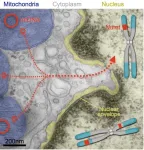Fisheries research overestimates fish stocks
GEOMAR expert calls for more realistic stock assessments
2024-08-22
(Press-News.org)
Many fish stocks around the world are either threatened by overfishing or have already collapsed. One of the main reasons for this devastating trend is that policymakers have often ignored the catch limits calculated by scientists, which were intended to be strict thresholds to protect stocks. But it has now become clear that even these scientific recommendations were often too high.
In the European Union (EU), for example, fisheries are primarily managed through allowable catch limits, known as quotas, which are set by the European Council of Agriculture Ministers on the basis of scientific advice and recommendations from the European Commission. A new study by Australian scientists (Edgar et al.) shows that already the scientific advice has been recommending catch limits that were too high.
The journal Science, where the study is published today, asked two of the world’s most cited fisheries experts, Dr Rainer Froese from the GEOMAR Helmholtz Centre for Ocean Research Kiel and Dr Daniel Pauly from the University of British Columbia, to interpret the findings. In their Perspective Paper, they advocate for simpler, yet more realistic models based on ecological principles, and call for more conservative stock assessments and management when uncertainties arise.
For the study, Edgar et al. analysed data from 230 fish stocks worldwide and found that stock assessments have often been overly optimistic. They overestimated the abundance of fish and how quickly stocks could recover. Particularly affected are stocks that have already shrunk due to overfishing. The overestimates led to so-called phantom recoveries, where stocks were classified as recovered while, in reality, they continued to decline. “This resulted in insufficient reductions in catch limits when they were most urgently needed,” explains Dr Rainer Froese. “Unfortunately, this is not just a problem of the past. Known overestimates of stock sizes in recent years are still not used to corrected this error in current stock assessments”.
The research by Edgar et al. also shows that almost a third of stocks classified by the Food and Agriculture Organization (FAO) as “maximally sustainably fished” have instead crossed the threshold into the “overfished” category. Moreover, the number of collapsed stocks (those with less than ten per cent of their original biomass) within the overfished category is likely to be 85 per cent higher than previously estimated.
But what causes these distortions in stock assessments? Standard stock assessments use models that can include more than 40 different parameters, such as fish life history, catch details, and fishing effort. This large number of parameters makes the assessments unnecessarily complex, write Froese and Pauly. The results can only be reproduced by a few experts with access to the original models, data and settings. Moreover, many of the required input parameters are unknown or difficult to estimate, leading modelers to use less reliable values that have worked in the past. Froese notes: “Such practices can skew the results towards the modelers' expectations”.
The authors therefore call for a revision of current stock assessment models. They advocate simpler, more realistic models based on ecological principles. They also call for greater use of the precautionary principle: when in doubt, conservative estimates should be used to protect stocks. “In essence, sustainable fishing is simple,” says Dr Rainer Froese. “Less fish biomass should be taken than is regrown.” Fish must be allowed to reproduce before they are caught, environmentally friendly fishing gear must be used and protected zones must be established. The functioning of important food chains must be preserved by reducing catches of forage fish such as anchovies, sardines, krill or herring – these are the principles of ecosystem-based sustainable fishing. Froese adds: “Four of these five principles can be implemented even without knowledge of stock sizes.”
END
ELSE PRESS RELEASES FROM THIS DATE:
2024-08-22
New research using neural networks, a form of brain-inspired AI, proposes a solution to the tough challenge of modelling the states of molecules.
The research shows how the technique can help solve fundamental equations in complex molecular systems.
This could lead to practical uses in the future, helping researchers to prototype new materials and chemical syntheses using computer simulation before trying to make them in the lab.
Led by Imperial College London and Google DeepMind scientists, the study is published today in Science.
Excited molecules
The team investigated the problem of understanding ...
2024-08-22
NEW YORK, NY (Aug. 22, 2024)--As direct descendants of ancient bacteria, mitochondria have always been a little alien.
Now a study shows that mitochondria are possibly even stranger than we thought.
Mitochondria in our brain cells frequently fling their DNA into the nucleus, the study found, where the DNA becomes integrated into the cells’ chromosomes. And these insertions may be causing harm: Among the study’s nearly 1,200 participants, those with more mitochondrial DNA insertions in their brain cells ...
2024-08-22
“DNA, RNA and proteins are the key players to regulate all processes in the cells of our body,” Leiden Professor John van Noort explains. “To understand the (mis-)functioning of these molecules, it is essential to uncover how their 3D structure depends on their sequence and for this it is necessary to measure them one molecule at a time. However, single-molecule measurements are laborious and slow, and the number of possible sequence variations is massive.”
From decades to days
Now the team of scientists developed an innovative tool, called SPARXS (Single-molecule Parallel Analysis for Rapid eXploration ...
2024-08-22
NEW YORK, NY (Aug. 22, 2024)--Columbia University announced today a new $400 million gift from Roy and Diana Vagelos, which will secure Columbia’s leadership in biomedical science research and education and produce a vast array of compelling opportunities for improving society’s health and wellbeing. The gift is the single largest ever made to Columbia’s medical school and, taken together with their previous giving, establishes Roy and Diana as the most generous donors in the history of Columbia University.
A ...
2024-08-22
BUFFALO, N.Y. — Air pollution is bad for mental health. That much is clear. Now, new research shows the impact may be even worse in neighborhoods that were historically redlined.
University at Buffalo researchers looked at 17 cities across New York State where longstanding federal housing policies once denied neighborhoods with people of color from receiving mortgages. Although this practice was outlawed in 1968, the researchers found that elevated levels of air pollutants in these neighborhoods of the state ...
2024-08-22
An international team of 45 researchers studying meteor showers has found that not all comets crumble the same way when they approach the Sun. In a paper published in the journal Icarus this week, they ascribe the differences to the conditions in the protoplanetary disk where comets formed 4.5 billion years ago.
“The meteoroids we see as meteors in the night sky are the size of small pebbles,” said lead author and SETI Institute and NASA Ames meteor astronomer Peter Jenniskens. “They are, in fact, the same size as the pebbles that collapsed into comets during the formation of ...
2024-08-22
August 22, 2024 — The groundbreaking ChatGPT chatbot shows potential as a time-saving tool for responding to patient questions sent to the urologist's office, suggests a study in the September issue of Urology Practice®, an Official Journal of the American Urological Association (AUA). The journal is published in the Lippincott portfolio by Wolters Kluwer.
The artificial intelligence (AI) tool generated "acceptable" responses to nearly one-half of a sample of real-life patient questions, according to the new research ...
2024-08-22
Research from Radboud university medical center reveals that T cells from the adaptive immune system can manipulate the memory of innate immune cells. Previously, it was believed that the memory of innate immune cells operated independently. This surprising connection opens up new possibilities for the treatment of various diseases. A mouse model shows that no immunosuppressive drugs are needed after an organ transplantation if this interaction between T cells and the innate immunity is temporarily blocked after the transplantation.
The adaptive immune ...
2024-08-22
GRAND RAPIDS, Mich. (Aug. 22, 2024) — Immune cells use two different routes to produce acetyl-CoA, an essential metabolite required to fight infection and cancer, reports a study led by Van Andel Institute scientists.
The findings, published in the Journal of Experimental Medicine, could help improve immunotherapies by revealing how diet can boost immune cell function.
“Like any good system, immune cells have a plan A and a plan B,” said Russell Jones, Ph.D., the study’s corresponding author and chair of VAI’s Department of Metabolism and Nutritional ...
2024-08-22
Many quantum devices, from quantum sensors to quantum computers, use ions or charged atoms trapped with electric and magnetic fields as a hardware platform to process information.
However, current trapped-ion systems face important challenges. Most experiments are limited to one-dimensional chains or two-dimensional planes of ions, which constrain the scalability and functionality of quantum devices. Scientists have long dreamed of stacking these ions into three-dimensional structures, but this has been very difficult ...
LAST 30 PRESS RELEASES:
[Press-News.org] Fisheries research overestimates fish stocks
GEOMAR expert calls for more realistic stock assessments




